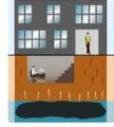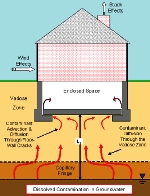
Vapor Intrusion and ASTM's Revised Vapor Encroachment Standard
The experts answer why the topic is so hot now and the best way you can protect your clients and yourself from liability.
By now, you’ve probably heard about the indoor air quality issue that develops when rapidly evaporating chemicals from polluted soil or groundwater make their way into indoor air. If not, you soon will — a spate of lawsuits, increased regulatory interest, and a recently revised ASTM screening standard have converged in a short period of time to bring the issue to the fore and effectively change due diligence best practices.
Here, I’ll answer your top three questions about vapor intrusion’s impacts, the new standard, and the best way to protect your clients — and yourself — from liability.
Vapor intrusion is not a new issue, so why is the industry abuzz?
It’s true, environmental professionals (EPs) have known for some time that vapor intrusion (VI) can present a health hazard for building occupants, drive down property values, expose owners and other stakeholders, including environmental consultants, to liability, and cost a tidy sum to investigate and mitigate. So why the sudden focus? There are several reasons. First, there is a growing public awareness of the health hazards associated with poor indoor air quality, driven in part by heightened media attention. Second, various state agencies — in California, New York, and Massachusetts, to name a few — are reopening formerly closed sites (those that had “no further action” letters) to examine whether exposure to vapor intrusion is a health concern, creating potential liability for property owners. Finally, ASTM’s vapor migration screening standard, issued this past June, provides stakeholders with a standardized methodology to evaluate the potential for vapors to encroach onto a property — and best practices are changing as a result. It is also raising issues about whether ASTM’s widely accepted E 1527-05 Phase I environmental site assessment standard should be clarified to reflect that vapor migration needs to be addressed analogous to groundwater migration in the determination of recognized environmental conditions associated with property environmental due diligence.
Why did ASTM revise its standard, and what are the implications for EPs?
ASTM published a vapor intrusion screening standard in 2008 at the behest of the commercial real estate industry (investors, Phase I professionals, lenders, insurers and attorneys, all stakeholders associated with the deal). Designed to address the increasing incidence of vapor intrusion conditions nationwide and to give stakeholders a framework for assessing potential risk, E2600-08 Standard Practice for Assessment of Vapor Intrusion into Structures on Property Involved in Real Estate Transactions unwittingly created considerable confusion in the marketplace. Stakeholders wondered, for example, whether E 2600-08 was a vapor intrusion assessment standard or a screening standard, and how it related to the Phase I standard (E 1527-05).
In response, ASTM published a revised standard in June 2010. Unlike its predecessor, ASTM E 2600-10 Standard Guide for Vapor Encroachment Screening on Property Involved in Real Estate Transactions focuses solely on screening for the likelihood of migrating vapors to encroach upon a target property and create a vapor encroachment condition (VEC). E2600-10 includes two screening tiers. The first relies on the existence of known or suspect contaminated sites in a specified area of concern, while the second, more comprehensive screening tier focuses on the contaminated plumes from these sites. (If plume information isn’t available, the consultant can rely on sampling.) If the likelihood exists for vapors to reach the subsurface of the property, further investigation may be necessary, but that is beyond the scope of E2600, according to Anthony Buonicore, P.E., CEO of The Buonicore Group and chair of the ASTM Task Group that developed both standards.
Early feedback indicates that the new standard is more in line with its intended purpose. “The 2010 revisions to E2600 made the screening more accessible,” said John Katze, EBI Consulting’s National ESA technical director. “With refinement of the area of concern (AOC), removal of the vapor intrusion assessment and mitigation sections, and sole focus on vapor migration screening, the intent of E2600 is now more consistent with that of E1527 in terms of assessment level.”
What is already receiving a great deal of attention (and is even being referred to as a “game changer” for CERCLA-driven All Appropriate Inquiry-compliant Phase I ESAs) is the new legal appendix in E 2600-10 that addresses the relationship between the new standard and the E 1527-05 Phase I standard. “Historically, [vapor intrusion] has been evaluated as a potential exposure pathway relative to Phase II subsurface investigations,” said Katze. “However, there is a growing opinion among several industry groups that assessment of vapor intrusion should be included as part of the Phase I ESA.”
LaNeicia Stone, a senior environmental technical adviser for EMG, agrees. “[ASTM’s standard] created an awareness of the potential impacts to the health of individuals occupying or living in properties with vapor intrusion risks above and beyond what environmental professionals normally thought to be a recognized environmental condition (REC).” Stone said the potential for vapor intrusion was not usually investigated during the Phase I, especially at properties where soil and groundwater contamination were thought to be adequately addressed, because vapor intrusion was considered an indoor air quality issue and therefore excluded under the basic scope of an E 1527-05 Phase I ESA.

“Not only did the release of E 2600-10 increase awareness about the potential impacts of vapor migration to a property once thought to be ‘clean,’” Stone said, “but it also opened an EP’s liability in cases where the vapor migration/intrusion risk to a property was not addressed. “
Indeed, a number of institutions, including the U.S. Department of Housing and Urban Development, as well as a growing number of lenders and commercial real estate attorneys, are requiring consultants to specifically include E 2600-10 Tier 1 vapor encroachment screening as part of the Phase I ESA, and the practice is expected to become standard operating procedure. “Spearheaded by the legal community, there is an interpretation that vapor migration screenings should have already been part of the Phase I ESA under the definition of a recognized environmental condition [‘a release … into structures on the property or into the ground, groundwater, or surface water of the property…’]” said Katze.
“The legal community has made it clear to us that under CERCLA, AAI and ASTM’s REC definition, vapor migration needs to be considered in Phase I REC determinations analogous to groundwater migration,” said Buonicore. “Although just because a VEC exists does not mean that it automatically constitutes a REC,” he added.
How can EPs best protect themselves and their clients?
If you are uncertain how to talk to your clients about vapor migration/intrusion risk and are concerned they might get the impression that you are just trying to up-sell them on yet another due diligence service, try to focus on educating them on the potentially costly impacts of ignoring a VI issue. “Vapor intrusion can not only create regulatory noncompliance but can also give rise to lawsuits from private parties,” explained Susan Phillips, an environmental attorney and partner with Mintz Levin. Claims can include allegations of property damage, including a reduction in value associated with stigma, and personal injury from breathing contaminated air.
For their part, environmental professionals should note that best practices are changing, which means that they, too, could be found negligent if they fail to address vapor migration impacts during the Phase I investigation. “Consultants usually specify a scope of services in their contracts and may be very specific about limiting an investigation to, e.g., performing an ASTM Phase I standard assessment and excluding business risk and other considerations,” explained Phillips. “But an EP who did not identify vapor migration/intrusion as a potential concern to its client and then drafted around an obligation to mention it could certainly be sued by its client if a VI issue were later discovered.”
Phillips explained that environmental professionals are held to a standard of care that typically requires them to exercise the same degree of care and skill that is ordinarily exercised by other members of the profession. “VI is such a hot topic in environmental law today with state agencies and with EPA and is now considered by so many consultants that to ignore it would be very risky,” she said. “Particularly since this is an area that gives rise to personal injury and property damage claims in addition to remediation costs, VI can lead to significant exposure for a client, and the client is then all the more likely to seek relief from an environmental professional who ‘missed’ it.”
What can you do? First, be sure you thoroughly understand the issues and that you’re familiar with the revised standard. (ASTM and others offer excellent training courses.) Next, be sure to proactively educate your clients. Stone said her company is creating a client education program to help customers understand the standard and its implications and is then evaluating clients’ scopes of work to ensure that they are maintaining defenses to CERCLA liability while protecting their own liability.
“Real estate turns over every five to eight years,” said Stone. “One of the most impactful statements I heard regarding vapor intrusion is that when real estate is sold in the future, the probability is virtually 100 percent that the EP conducting the Phase I will consider vapors encroaching upon the subsurface of the property as part of the REC determination. To avoid future litigation, the sooner EPs incorporate that into their own scope, the better.”
That’s not the only overlap between the real estate industry and VEC screenings. Risk aversion is in the front seat now and the environment has shifted: from one in which no risk was too big to one in which no risk is too small. “As the economy strengthens and deal flow increases, there is a new focus on potential vapor encroachment conditions,” confirmed Elizabeth Krol, P.G., client program manager and Northeast Due Diligence Manager for Shaw. EPs should be prepared.
For more information, visit www.edrnet.com/vi
About the Author
Dianne Crocker is senior economist and managing director of EDR's Market Research Group. With 15 years of experience in the environmental industry, Crocker provides strategic data and analysis on environmental due diligence trends to environmental consultants, lenders, corporations, and other parties involved in commercial real estate transactions.